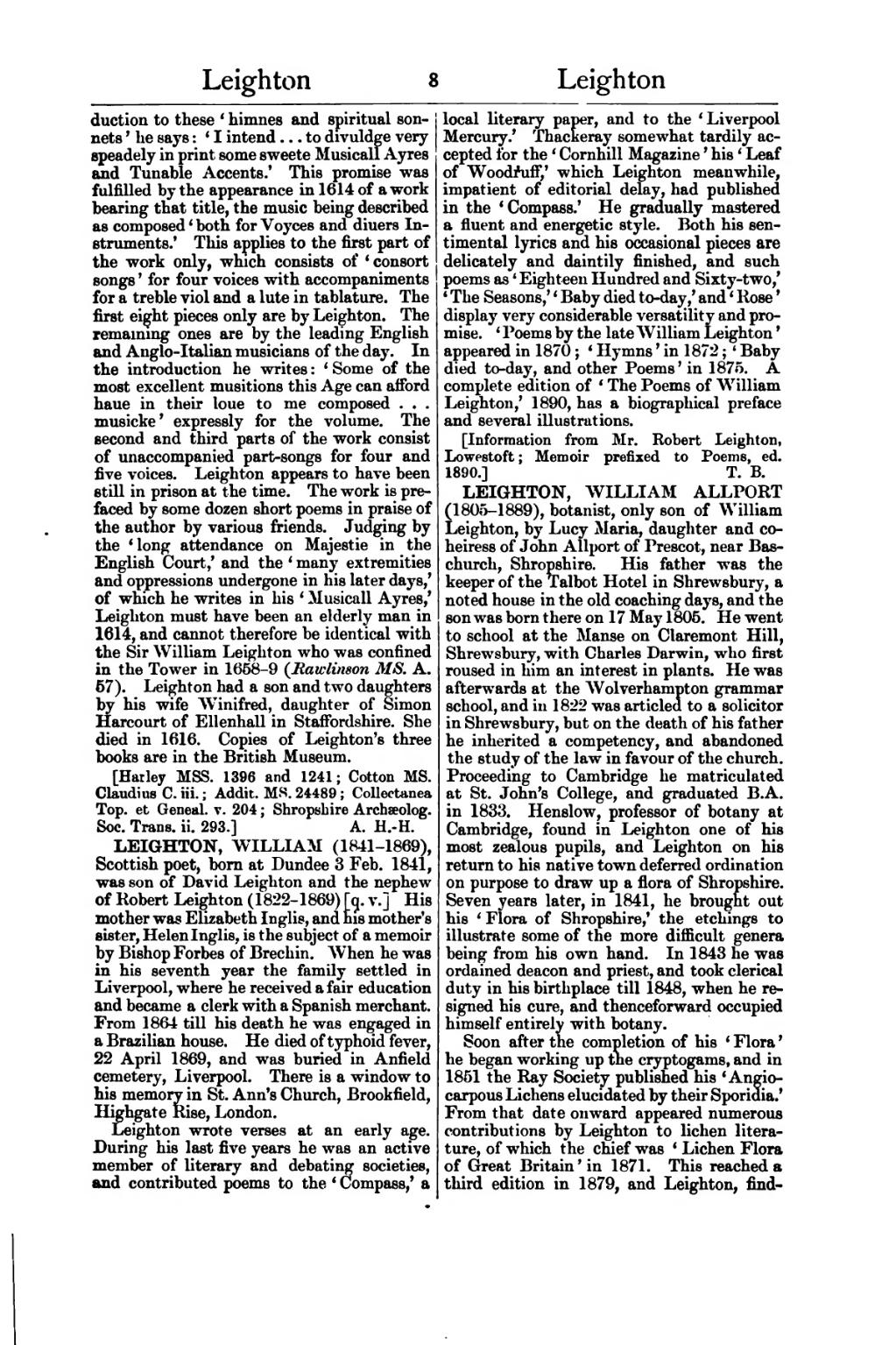duction to these ‘himnes and spiritual sonnets’ he says: ‘I intend … to divuldge very speadely in print some sweete Musicall Ayres and Tunable Accents.’ This promise was fulfilled by the appearance in 1614 of a work bearing that title, the music being described as composed ‘both for Voyces and diuers Instruments.’ This applies to the first part of the work only, which consists of ‘consort songs’ for four voices with accompaniments for a treble viol and a lute in tablature. The first eight pieces only are by Leighton. The remaining ones are by the leading English and Anglo-Italian musicians of the day. In the introduction he writes: ‘Some of the most excellent musitions this Age can afford haue in their loue to me composed … musicke’ expressly for the volume. The second and third parts of the work consist of unaccompanied part-songs for four and five voices. Leighton appears to have been still in prison at the time. The work is prefaced by some dozen short poems in praise of the author by various friends. Judging by the ‘long attendance on Majestie in the English Court,’ and the ‘many extremities and oppressions undergone in his later days,’ of which he writes in his ‘Musicall Ayres,’ Leighton must have been an elderly man in 1614, and cannot therefore be identical with the Sir William Leighton who was confined in the Tower in 1658–9 (Rawlinson MS. A. 57). Leighton had a son and two daughters by his wife Winifred, daughter of Simon Harcourt of Ellenhall in Staffordshire. She died in 1616. Copies of Leighton's three books are in the British Museum.
[Harley MSS. 1396 and 1241; Cotton MS. Claudius C. iii.; Addit. MS. 24489; Collectanea Top. et Geneal. v. 204; Shropshire Archæolog. Soc. Trans. ii. 293.]
LEIGHTON, WILLIAM (1841–1869), Scottish poet, born at Dundee 3 Feb. 1841, was son of David Leighton and the nephew of Robert Leighton (1822–1869) [q. v.] His mother was Elizabeth Inglis, and his mother's sister, Helen Inglis, is the subject of a memoir by Bishop Forbes of Brechin. When he was in his seventh year the family settled in Liverpool, where he received a fair education and became a clerk with a Spanish merchant. From 1864 till his death he was engaged in a Brazilian house. He died of typhoid fever, 22 April 1869, and was buried in Anfield cemetery, Liverpool. There is a window to his memory in St. Ann's Church, Brookfield, Highgate Rise, London.
Leighton wrote verses at an early age. During his last five years he was an active member of literary and debating societies, and contributed poems to the ‘Compass,’ a local literary paper, and to the ‘Liverpool Mercury.’ Thackeray somewhat tardily accepted for the ‘Cornhill Magazine’ his ‘Leaf of Woodruff,’ which Leighton meanwhile, impatient of editorial delay, had published in the ‘Compass.’ He gradually mastered a fluent and energetic style. Both his sentimental lyrics and his occasional pieces are delicately and daintily finished, and such poems as ‘Eighteen Hundred and Sixty-two,’ ‘The Seasons,’ ‘Baby died to-day,’ and ‘Rose’ display very considerable versatility and promise. ‘Poems by the late William Leighton’ appeared in 1870; ‘Hymns’ in 1872; ‘Baby died to-day, and other Poems’ in 1875. A complete edition of ‘The Poems of William Leighton,’ 1890, has a biographical preface and several illustrations.
[Information from Mr. Robert Leighton, Lowestoft; Memoir prefixed to Poems, ed. 1890.]
LEIGHTON, WILLIAM ALLPORT (1805–1889), botanist, only son of William Leighton, by Lucy Maria, daughter and coheiress of John Allport of Prescot, near Baschurch, Shropshire. His father was the keeper of the Talbot Hotel in Shrewsbury, a noted house in the old coaching days, and the son was born there on 17 May 1805. He went to school at the Manse on Claremont Hill, Shrewsbury, with Charles Darwin, who first roused in him an interest in plants. He was afterwards at the Wolverhampton grammar school, and in 1822 was articled to a solicitor in Shrewsbury, but on the death of his father he inherited a competency, and abandoned the study of the law in favour of the church. Proceeding to Cambridge he matriculated at St. John's College, and graduated B.A. in 1833. Henslow, professor of botany at Cambridge, found in Leighton one of his most zealous pupils, and Leighton on his return to his native town deferred ordination on purpose to draw up a flora of Shropshire. Seven years later, in 1841, he brought out his ‘Flora of Shropshire,’ the etchings to illustrate some of the more difficult genera being from his own hand. In 1843 he was ordained deacon and priest, and took clerical duty in his birthplace till 1848, when he resigned his cure, and thenceforward occupied himself entirely with botany.
Soon after the completion of his ‘Flora’ he began working up the cryptogams, and in 1851 the Ray Society published his ‘Angiocarpous Lichens elucidated by their Sporidia.’ From that date onward appeared numerous contributions by Leighton to lichen literature, of which the chief was ‘Lichen Flora of Great Britain’ in 1871. This reached a third edition in 1879, and Leighton, find--
